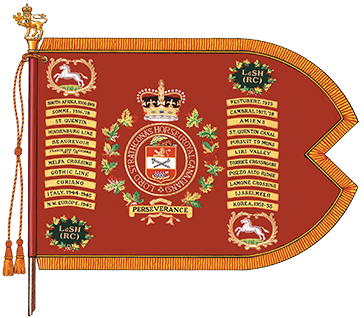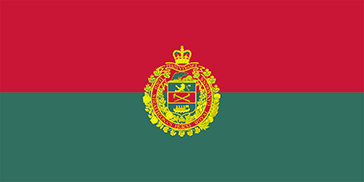Lord Strathcona’s Horse (Royal Canadians)
The official lineage of Lord Strathcona’s Horse (Royal Canadians) armour regiment.

Badge
Description
The Arms (Gules a fess Argent charged with a hammer and nail in saltire Sable, in chief a demi lion rampant Or, in base a canoe paddled by four men proper, in the stern a flag Argent flowing towards the dexter inscribed NW in letters Sable) and Crest (On a mount a beaver gnawing at a tree proper) of Sir Donald Alexander Smith, 1st Baron Strathcona and Mount Royal, beneath a scroll Gules edged and inscribed PERSEVERANCE in letters Or, and within a chaplet of maple leaves, roses, thistles and shamrocks proper surmounted by a scroll Gules edged and inscribed LORD STRATHCONA'S HORSE ROYAL CANADIANS in letters Or, the whole ensigned by the Royal Crown proper.
Symbolism
The Crown represents service to the Sovereign. The shield, beaver and maple tree were the coat of arms and crest of the first Lord Strathcona and were taken from symbols used by the North West Company. The wreath of roses, thistles, shamrocks and maple leaves represents Canada's ethnic link with Great Britain. "LORD STRATHCONA'S HORSE ROYAL CANADIANS" is a form of the regimental title and "PERSEVERANCE" is the motto of the regiment.
Motto
PERSEVERANCE
March
Soldiers of the Queen
Alliance
British Army
The Queen's Royal Lancers
Guidon

Camp flag

Battle honours
South African War
SOUTH AFRICA, 1900-1901.
The First World War
FESTUBERT, 1915; SOMME, 1916, '18; Bazentin; Pozières; Flers-Courcelette; CAMBRAI, 1917, '18; St. Quentin; AMIENS; HINDENBURG LINE; St. Quentin Canal; Beaurevoir; PURSUIT TO MONS; FRANCE AND FLANDERS, 1915-18.
The Second World War
LIRI VALLEY; Melfa Crossing; Torrice Crossroads; GOTHIC LINE; Pozzo Alto Ridge; CORIANO; LAMONE CROSSING; Misano Ridge; Casale; Naviglio Canal; Fosso Munio; ITALY, 1944-1945; Ijsselmeer; NORTH-WEST EUROPE, 1945.
United nations Operations - Korea
Korea, 1951-1953
South-West Asia
AFGHANISTAN
Lineage
This Regular Force regiment originated in Winnipeg, Manitoba on 1 July 1901 when an independent Permanent Active Militia corps of mounted rifles, designated 'A Squadron, The Canadian Mounted Rifles', was authorized to be formed.Footnote 1 It was redesignated: 'The Royal Canadian Mounted Rifles' on 1 October 1903;Footnote 2 'Strathcona's Horse (Royal Canadians)' on 1 October 1909;Footnote 3 'Lord Strathcona's Horse (Royal Canadians)' on 1 May 1911;Footnote 4 '2nd Armoured Regiment (Lord Strathcona's Horse (Royal Canadians)), RCAC' on 16 October 1946;Footnote 5 'Lord Strathcona's Horse (Royal Canadians) (2nd Armoured Regiment)' on 2 March 1949;Footnote 6 and 'Lord Strathcona's Horse (Royal Canadians)' on 19 May 1958.Footnote 7
Perpetuations
'Strathcona's Horse' of 1900-1901Footnote 8
Headquarters Location
Edmonton, Alberta
Operational history
South African War
The 'Strathcona's Horse', which was authorized on 1 February 1900,Footnote 9 embarked for Africa on 17 March 1900.Footnote 10 It fought as part of the '3rd Mounted Brigade' and '4th Infantry Brigade, II Division' until its departure from the theatre of operations on 20 January 1901.Footnote 11 The unit was disbanded on 9 March 1901.Footnote 12
The First World War
The regiment was placed on active service on 6 August 1914 for instructional and camp administration duties.Footnote 13 On 14 September 1914 they mobilized the 'The Lord Strathcona's Horse (Royal Canadians), CEF',Footnote 14 which embarked for England on 3 October 1914.Footnote 15 On 5 May 1915 it disembarked in France,Footnote 16 where it fought in an infantry role with 'Seeley's Detachment', 1st Canadian Division.Footnote 17 On 27 January 1916, it resumed its cavalry role as part of the '1st Canadian Cavalry Brigade', with whom it continued to fight in France and Flanders until the end of the war.Footnote 18 The overseas regiment was disbanded on 6 November 1920.Footnote 19
The Second World War
On 24 May 1940, the headquarters and one squadron were mobilized together with headquarters and one squadron of 'The Royal Canadian Dragoons' to form the '1st Canadian Motorcycle Regiment, CASF (RCD/LSH(RC))'.Footnote 20 It was redesignated: 'Lord Strathcona's Horse (Royal Canadians), CASF' on 21 September 1940;Footnote 21 '2nd Armoured Regiment (Lord Strathcona's Horse (Royal Canadians)), CASF' on 11 February 1941;Footnote 22 '2nd Armoured Regiment (Lord Strathcona's Horse (Royal Canadians)), CAC, CASF' on 15 October 1943;Footnote 23 and '2nd Armoured Regiment (Lord Strathcona's Horse (Royal Canadians)), RCAC, CASF' on 2 August 1945.Footnote 24 It embarked for Britain on 13 November 1941.Footnote 25 The regiment landed in Italy on 8 November 1943, where it fought as part of the 5th Armoured Brigade, 5th Canadian Armoured Division.Footnote 26 On 16 February 1945 the regiment moved with the 1st Canadian Corps to North-West Europe, where it fought until the end of the war.Footnote 27 The overseas regiment was disbanded on 1 March 1946.Footnote 28
On 1 September 1945 a second Active Force component of the regiment was mobilized for service in the Pacific theatre of operations under the designation '2nd-2nd Armoured Car Regiment (Lord Strathcona's Horse (Royal Canadians)), RCAC, CASF'.Footnote 29 It was redesignated the '2nd Armoured Regiment (Lord Strathcona's Horse (Royal Canadians)), RCAC, CASF)' on 1 March 1946.Footnote 30 On 27 June 1946 it was embodied in the Permanent Force.Footnote 31
United Nations Operations - Korea
'A', 'B' and 'C' Squadrons fought independently from 19 April 1951 to 27 July 1953 as part of the 25th Canadian Infantry Brigade Group, 1st Commonwealth Division.Footnote 32
Notes:
'C Squadron' was the first to arrive in Korea, followed by 'B' then 'A' Squadron. C Squadron was mobilized for active service on 7 August 1950, under the designation 'A Squadron, 1st/2nd Canadian Armoured Regiment, RCAC, CASF' (CAO 110-2, Pt 'A', Supp Issue No. 210/50). It was redesignated 'C Squadron, Lord Strathcona's Horse (Royal Canadians), 2nd Armoured Regiment, RCAC, CASF' on 29 March 1951 (CAO 76-2, Pt 'A', Supp Issue No. 226/51). The squadron ceased to be embodied in the Canadian Army Special Force on 14 July 1952 (CAO 76-8, Pt 'B', Supp Issue No. 293/52).
On 8 November 1950 'B Squadron' was placed on active service, under the designation 'B Squadron, Lord Strathcona's Horse (Royal Canadians) 2nd Armoured Regiment, RCAC, CASF' (CAO 76-8, Pt 'B', Supp Issue No. 273/52). The squadron ceased to be embodied in the Canadian Army Special Force on 10 June 1953 (CAO 76-8, Pt 'B', Supp Issue No. 345/53).
On 1 March 1953 'A Squadron' was placed on active service, under the designation 'A Squadron, Lord Strathcona's Horse (Royal Canadians) 2nd Armoured Regiment, RCAC, CASF' (CAO 76-8, Pt 'B', Supp Issue No. 324/53). The squadron ceased to be embodied in the Canadian Army Special Force on 1 November 1953 (CAO 76-8, Pt 'B', Supp Issue No. 365/53).
South-West Asia
Lord Strathcona's Horse (Royal Canadians) provided several Tank Squadrons to the Canadian Task Forces that served in Afghanistan from 2002 to 2014.Footnote 33
Page details
- Date modified: